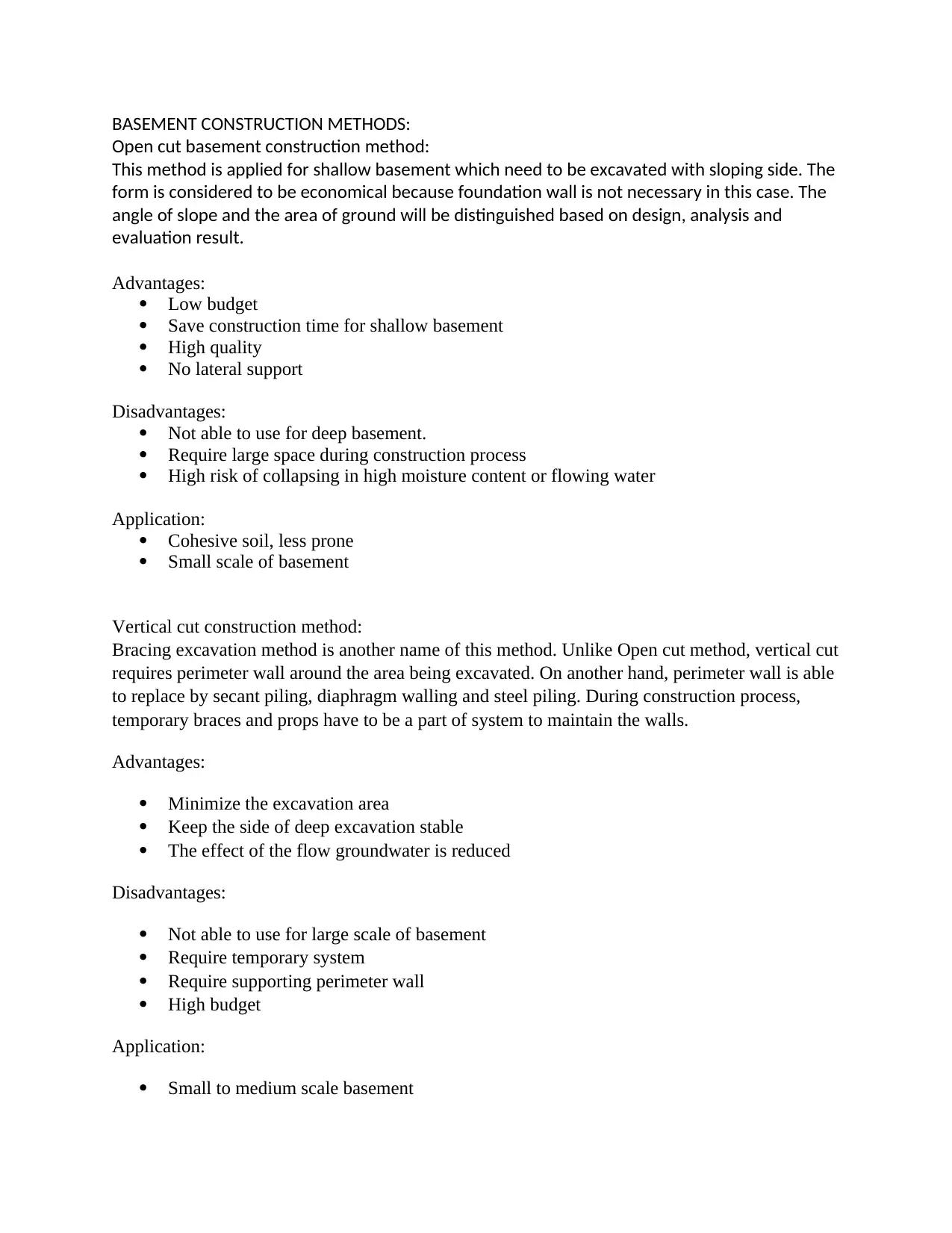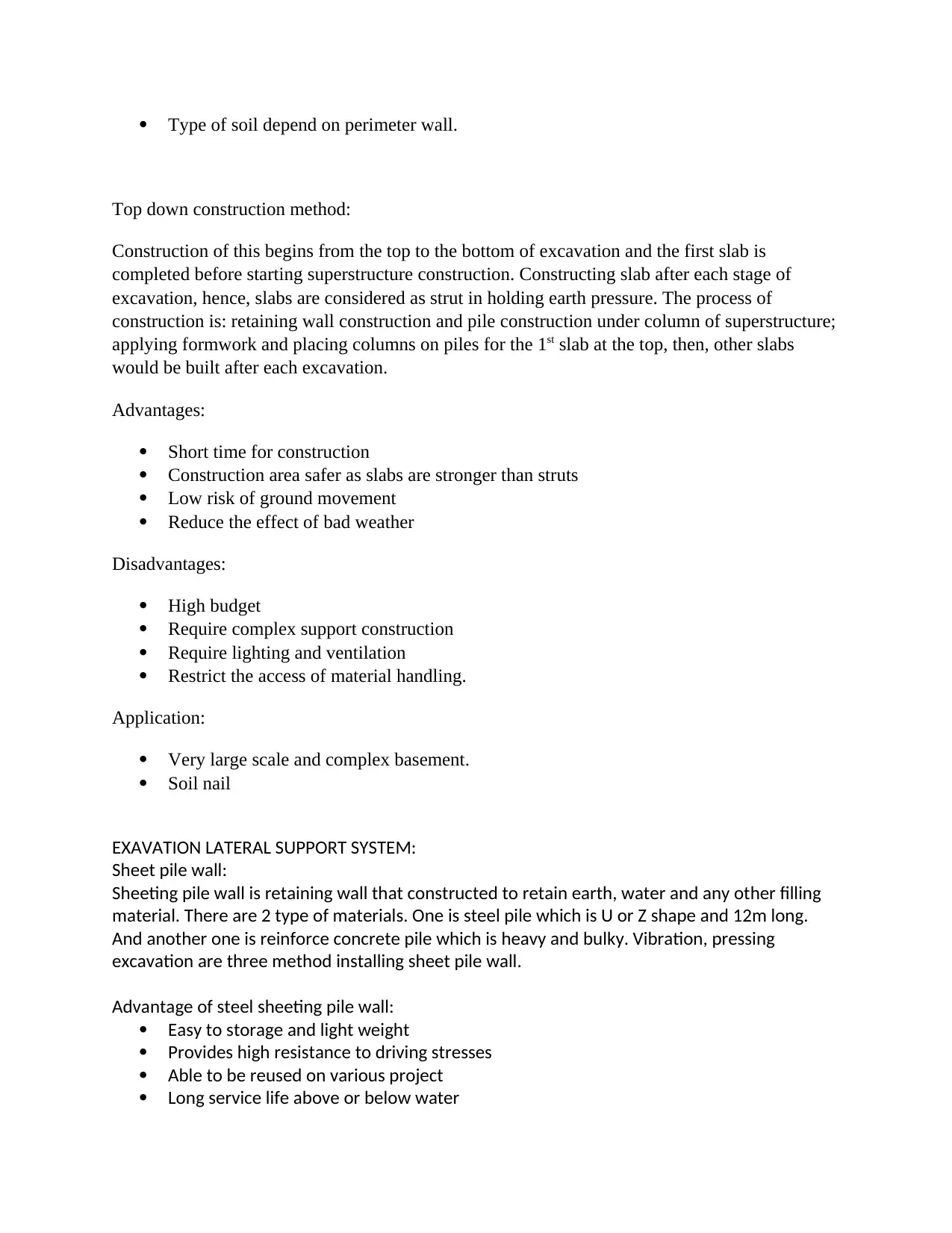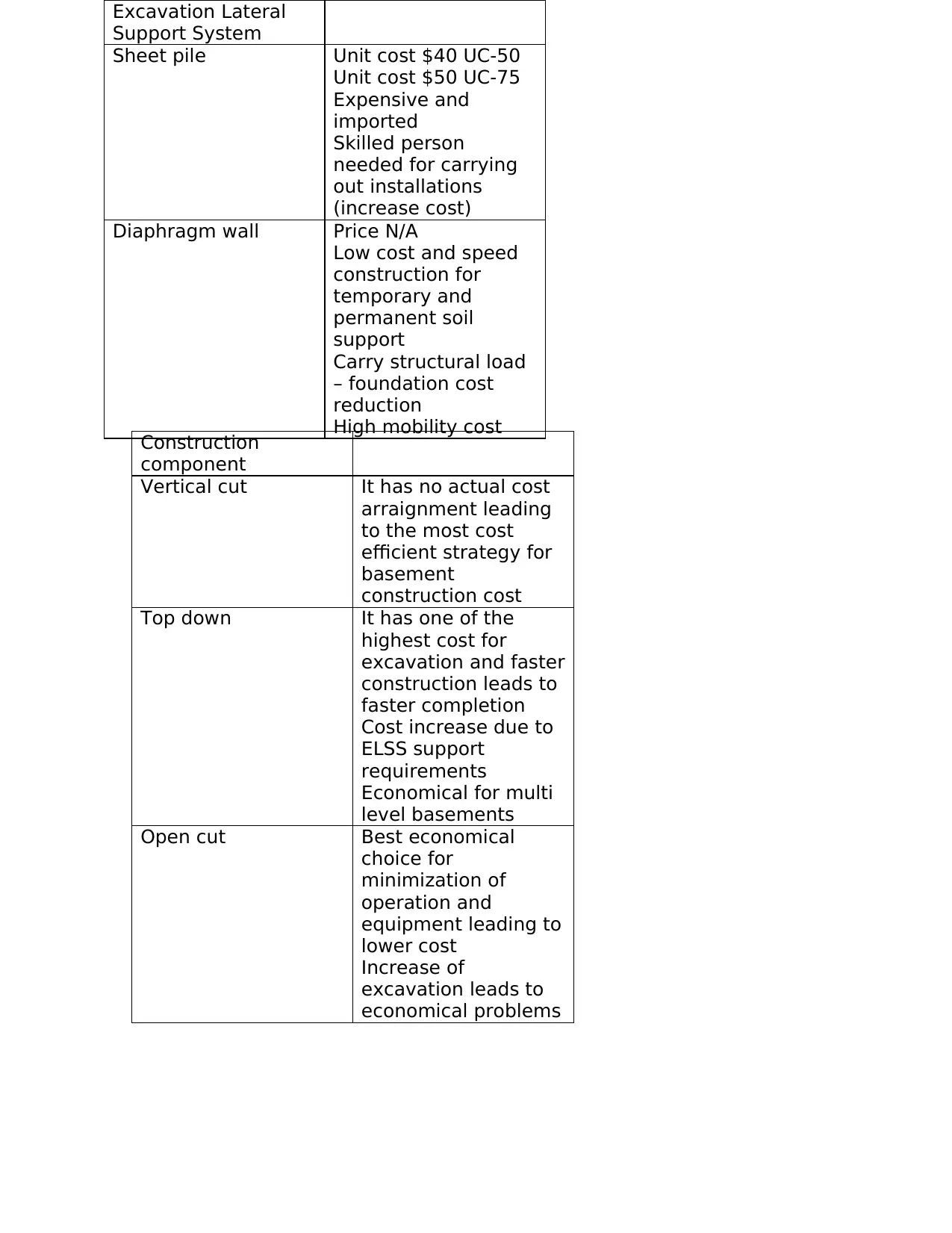Comparative Analysis of Basement Construction Methods and Systems
VerifiedAdded on 2019/09/26
|5
|1081
|7181
Report
AI Summary
This report provides a detailed overview of various basement construction methods, including open cut, vertical cut, and top-down approaches, along with their respective advantages, disadvantages, and applications. It explores excavation lateral support systems such as sheet pile walls, diaphragm walls, and secant piling, discussing their characteristics and suitability for different scenarios. Furthermore, the report delves into foundation systems, comparing pad footings, raft footings, and strip footings in terms of cost-effectiveness and performance. A cost comparison analysis is included, examining the financial implications of each method and system. The report concludes by highlighting the importance of selecting the most appropriate construction and support methods based on factors such as site conditions, project scale, and budget constraints. The report is designed to assist students in civil engineering to understand and choose appropriate methods for basement construction.

BASEMENT CONSTRUCTION METHODS:
Open cut basement construction method:
This method is applied for shallow basement which need to be excavated with sloping side. The
form is considered to be economical because foundation wall is not necessary in this case. The
angle of slope and the area of ground will be distinguished based on design, analysis and
evaluation result.
Advantages:
Low budget
Save construction time for shallow basement
High quality
No lateral support
Disadvantages:
Not able to use for deep basement.
Require large space during construction process
High risk of collapsing in high moisture content or flowing water
Application:
Cohesive soil, less prone
Small scale of basement
Vertical cut construction method:
Bracing excavation method is another name of this method. Unlike Open cut method, vertical cut
requires perimeter wall around the area being excavated. On another hand, perimeter wall is able
to replace by secant piling, diaphragm walling and steel piling. During construction process,
temporary braces and props have to be a part of system to maintain the walls.
Advantages:
Minimize the excavation area
Keep the side of deep excavation stable
The effect of the flow groundwater is reduced
Disadvantages:
Not able to use for large scale of basement
Require temporary system
Require supporting perimeter wall
High budget
Application:
Small to medium scale basement
Open cut basement construction method:
This method is applied for shallow basement which need to be excavated with sloping side. The
form is considered to be economical because foundation wall is not necessary in this case. The
angle of slope and the area of ground will be distinguished based on design, analysis and
evaluation result.
Advantages:
Low budget
Save construction time for shallow basement
High quality
No lateral support
Disadvantages:
Not able to use for deep basement.
Require large space during construction process
High risk of collapsing in high moisture content or flowing water
Application:
Cohesive soil, less prone
Small scale of basement
Vertical cut construction method:
Bracing excavation method is another name of this method. Unlike Open cut method, vertical cut
requires perimeter wall around the area being excavated. On another hand, perimeter wall is able
to replace by secant piling, diaphragm walling and steel piling. During construction process,
temporary braces and props have to be a part of system to maintain the walls.
Advantages:
Minimize the excavation area
Keep the side of deep excavation stable
The effect of the flow groundwater is reduced
Disadvantages:
Not able to use for large scale of basement
Require temporary system
Require supporting perimeter wall
High budget
Application:
Small to medium scale basement
Paraphrase This Document
Need a fresh take? Get an instant paraphrase of this document with our AI Paraphraser

Type of soil depend on perimeter wall.
Top down construction method:
Construction of this begins from the top to the bottom of excavation and the first slab is
completed before starting superstructure construction. Constructing slab after each stage of
excavation, hence, slabs are considered as strut in holding earth pressure. The process of
construction is: retaining wall construction and pile construction under column of superstructure;
applying formwork and placing columns on piles for the 1st slab at the top, then, other slabs
would be built after each excavation.
Advantages:
Short time for construction
Construction area safer as slabs are stronger than struts
Low risk of ground movement
Reduce the effect of bad weather
Disadvantages:
High budget
Require complex support construction
Require lighting and ventilation
Restrict the access of material handling.
Application:
Very large scale and complex basement.
Soil nail
EXAVATION LATERAL SUPPORT SYSTEM:
Sheet pile wall:
Sheeting pile wall is retaining wall that constructed to retain earth, water and any other filling
material. There are 2 type of materials. One is steel pile which is U or Z shape and 12m long.
And another one is reinforce concrete pile which is heavy and bulky. Vibration, pressing
excavation are three method installing sheet pile wall.
Advantage of steel sheeting pile wall:
Easy to storage and light weight
Provides high resistance to driving stresses
Able to be reused on various project
Long service life above or below water
Top down construction method:
Construction of this begins from the top to the bottom of excavation and the first slab is
completed before starting superstructure construction. Constructing slab after each stage of
excavation, hence, slabs are considered as strut in holding earth pressure. The process of
construction is: retaining wall construction and pile construction under column of superstructure;
applying formwork and placing columns on piles for the 1st slab at the top, then, other slabs
would be built after each excavation.
Advantages:
Short time for construction
Construction area safer as slabs are stronger than struts
Low risk of ground movement
Reduce the effect of bad weather
Disadvantages:
High budget
Require complex support construction
Require lighting and ventilation
Restrict the access of material handling.
Application:
Very large scale and complex basement.
Soil nail
EXAVATION LATERAL SUPPORT SYSTEM:
Sheet pile wall:
Sheeting pile wall is retaining wall that constructed to retain earth, water and any other filling
material. There are 2 type of materials. One is steel pile which is U or Z shape and 12m long.
And another one is reinforce concrete pile which is heavy and bulky. Vibration, pressing
excavation are three method installing sheet pile wall.
Advantage of steel sheeting pile wall:
Easy to storage and light weight
Provides high resistance to driving stresses
Able to be reused on various project
Long service life above or below water

Easy to adapt the pile length
Joints are less apt to deform during driving.
Disadvantages:
Sections can rarely be used as part of the permanent structure.
Installation of sheet piles is difficult in soils with boulders or cobbles. In such cases, the
desired wall depths may not be reached.
Excavation shapes are dictated by the sheet pile section and interlocking elements.
Sheet pile driving may cause neighbourhood disturbance
Settlements in adjacent properties may take place due to installation vibrations
High budget.
Application:
Water front structures, i.e. in building wharfs, quays and piers.
Building diversion dams, such as cofferdams
River bank protection
Retaining the sides of cuts made in earth.
Diaphragm wall:
Diaphragm wall is a reinforced concrete structure constructed in-sity panel by panel. The wall is
usually designed to reach very great depth, sometimes up to 50m, mechanical excavating
method is applied.
Advantages:
Can be used as permanent structural wall
Water retainable
Can be installed to deeper depths and for load bearing element
Less temporary propping needed
Can be applied for top-down construction method
Rigid structure so that ground movement induced by basement excavation is less than
other flexible retaining wall
Vibration and noise generated from installation of diaphragm wall is less than other
methods
Disadvantages:
Large site area and limit headroom
High cost for mobilization.
Secant piling:
The secant pile uses The secant pile uses concrete of different strengths for a series of piles that
overlap each other, creating a sealed wall face. The primary piles are made with unreinforced
concrete. They are driven first. After they have been allowed to set, they drill for the reinforced
concrete piles, or secondary pile, by drilling into a portion of the primary pile.
Advantages:
Joints are less apt to deform during driving.
Disadvantages:
Sections can rarely be used as part of the permanent structure.
Installation of sheet piles is difficult in soils with boulders or cobbles. In such cases, the
desired wall depths may not be reached.
Excavation shapes are dictated by the sheet pile section and interlocking elements.
Sheet pile driving may cause neighbourhood disturbance
Settlements in adjacent properties may take place due to installation vibrations
High budget.
Application:
Water front structures, i.e. in building wharfs, quays and piers.
Building diversion dams, such as cofferdams
River bank protection
Retaining the sides of cuts made in earth.
Diaphragm wall:
Diaphragm wall is a reinforced concrete structure constructed in-sity panel by panel. The wall is
usually designed to reach very great depth, sometimes up to 50m, mechanical excavating
method is applied.
Advantages:
Can be used as permanent structural wall
Water retainable
Can be installed to deeper depths and for load bearing element
Less temporary propping needed
Can be applied for top-down construction method
Rigid structure so that ground movement induced by basement excavation is less than
other flexible retaining wall
Vibration and noise generated from installation of diaphragm wall is less than other
methods
Disadvantages:
Large site area and limit headroom
High cost for mobilization.
Secant piling:
The secant pile uses The secant pile uses concrete of different strengths for a series of piles that
overlap each other, creating a sealed wall face. The primary piles are made with unreinforced
concrete. They are driven first. After they have been allowed to set, they drill for the reinforced
concrete piles, or secondary pile, by drilling into a portion of the primary pile.
Advantages:
⊘ This is a preview!⊘
Do you want full access?
Subscribe today to unlock all pages.

Trusted by 1+ million students worldwide

Increased construction alignment flexibility to fit complex site boundaries, maximising
land use.
Increased wall stiffness compared to sheet piles. Reducing the risk of adjacent ground
movements.
Suit difficult ground (cobbles/boulders) and confined site space.
Minimal vibration and low noise.
Disadvantages:
Difficulty in joint and verticality control
Lower reinforcement efficiency
Higher cost compared to sheet piles and slow operation
For construction process, please use
Basement construction method: Vertical cut
Excavation lateral support system: sheet pile wall
Foundation: raft foundation
Cost comparison: here is example of that
Foundation System
Pad footing Simple and most cost
effective
Raft footing Economic due to
combining
foundation and floor
slab
Foundation required
less than others
leading to decrease
resources / labor /
cost
Strip footing Low cost – long
service life
land use.
Increased wall stiffness compared to sheet piles. Reducing the risk of adjacent ground
movements.
Suit difficult ground (cobbles/boulders) and confined site space.
Minimal vibration and low noise.
Disadvantages:
Difficulty in joint and verticality control
Lower reinforcement efficiency
Higher cost compared to sheet piles and slow operation
For construction process, please use
Basement construction method: Vertical cut
Excavation lateral support system: sheet pile wall
Foundation: raft foundation
Cost comparison: here is example of that
Foundation System
Pad footing Simple and most cost
effective
Raft footing Economic due to
combining
foundation and floor
slab
Foundation required
less than others
leading to decrease
resources / labor /
cost
Strip footing Low cost – long
service life
Paraphrase This Document
Need a fresh take? Get an instant paraphrase of this document with our AI Paraphraser

Excavation Lateral
Support System
Sheet pile Unit cost $40 UC-50
Unit cost $50 UC-75
Expensive and
imported
Skilled person
needed for carrying
out installations
(increase cost)
Diaphragm wall Price N/A
Low cost and speed
construction for
temporary and
permanent soil
support
Carry structural load
– foundation cost
reduction
High mobility cost
Construction
component
Vertical cut It has no actual cost
arraignment leading
to the most cost
efficient strategy for
basement
construction cost
Top down It has one of the
highest cost for
excavation and faster
construction leads to
faster completion
Cost increase due to
ELSS support
requirements
Economical for multi
level basements
Open cut Best economical
choice for
minimization of
operation and
equipment leading to
lower cost
Increase of
excavation leads to
economical problems
Support System
Sheet pile Unit cost $40 UC-50
Unit cost $50 UC-75
Expensive and
imported
Skilled person
needed for carrying
out installations
(increase cost)
Diaphragm wall Price N/A
Low cost and speed
construction for
temporary and
permanent soil
support
Carry structural load
– foundation cost
reduction
High mobility cost
Construction
component
Vertical cut It has no actual cost
arraignment leading
to the most cost
efficient strategy for
basement
construction cost
Top down It has one of the
highest cost for
excavation and faster
construction leads to
faster completion
Cost increase due to
ELSS support
requirements
Economical for multi
level basements
Open cut Best economical
choice for
minimization of
operation and
equipment leading to
lower cost
Increase of
excavation leads to
economical problems
1 out of 5
Your All-in-One AI-Powered Toolkit for Academic Success.
+13062052269
info@desklib.com
Available 24*7 on WhatsApp / Email
![[object Object]](/_next/static/media/star-bottom.7253800d.svg)
Unlock your academic potential
Copyright © 2020–2025 A2Z Services. All Rights Reserved. Developed and managed by ZUCOL.
